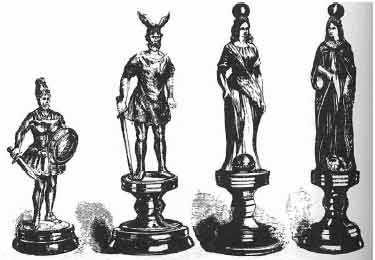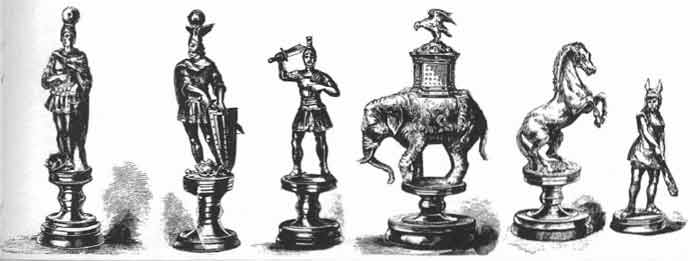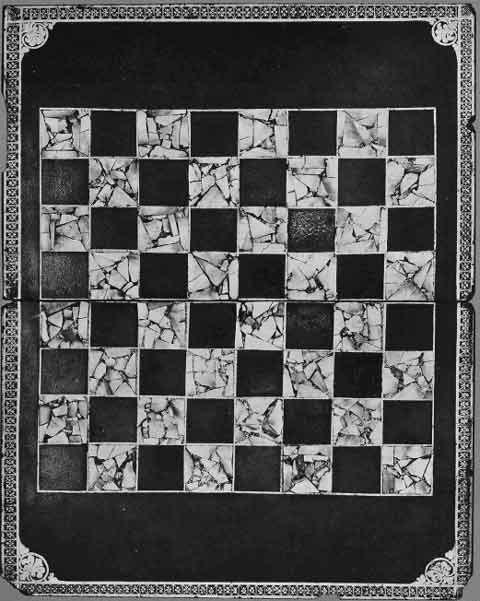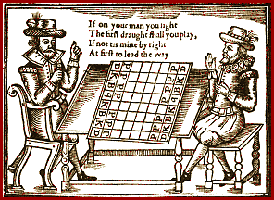At the May 25, 1859 testimonial banquet given at the
chapel of the New York University
in Paul Morphy's honor upon his return from Europe, Morphy was presented
with a watch and a chess board and pieces. Both were remarkable works of
art.
After Morphy's death both the board and
pieces were auctioned off and became the property of Walter D. Denegre,
a gentleman from New Orleans who acted as a middleman for an unknown
client. For a long time there wasn't any hint of their whereabouts.
Then the British Chess Magazine mentioned in it's December 1885 issue
that the "gold and silver men were offered for sale to the St. George's
Chess Club "at the rather prohibited price of £1,000."
The board and pieces are unaccounted for to this day.
A close acquaintance of Paul Morphy who had ample opportunity to study
the testimonial gift wrote the following detailed description:


The chess-men, which are the conspicuous objects of the - "Morphy
Testimonial," are of the purest gold and silver, and with the exception of
their cornelian pedestals - of those materials alone. In design and
execution, as well as in intrinsic value, the set is, so far as we are
informed, unequalled - that in the possession of Queen Victoria, though of
similar design, being of inferior proportions. The connoisseur will
especially remark the exquisite details of the artist's conception. As
chess is a regal game, the pieces in this superb set are appropriately
modeled after a study of one of the grandest historic episodes - the
contest between Christianity and Barbarism. "The Reds," or the gold
pieces, are highly-finished statuettes, reproducing the components of an
imperial array in the days when Kings and Queens went forth with their
armies, and bishops, exchanging mitre and crosier for battle-ax and sword,
transferred the war of proselytism from the sanctuary to the field. The
"Whites," or silver pieces, in happy contrast, represent the Northern
horde, which disputed the domination of Theodosius, or, at a later period,
for a while withstood the march of Clovis and Clothilde.
In detail, the pieces are as follows: The golden King is a statuette, four
inches in height, and weighing three ounces; royal robes gracefully
falling over his armor; the imperial globe upon his martially defended
head; the crown and sceptre at his feet; by his side an elegant shield,
and in his right-hand the sword of empire. The Queen, arrayed in
character, is of proportions slightly inferior to those of her lord. The
Bishops, in the full panoply of warriors, three and a half inches in
height, stand perceptibly inclined forward, grasping drawn swords with
blades advanced. The Knights, on both sides, are admirably-sculptured
chargers, prancing nearly upright, and ruby-eyed. In the rooks, or
castles, the artist has adopted the Chinese design, and flanked the rear
lines by stately elephants, each bearing an eastern houdah, upon which an
elegantly-wrought eagle is spreading his pinions, as if to pounce upon his
prey.
The eyes of both bird and beast are brilliant rubies. The finish of this
piece is especially admirable, the artist having achieved a manifest
triumph in the contrast, which his fine casting has effected between the
coarse hide of the elephant and the tiger-skin mantle of the houdah. This
elaborate piece is three and three quarter inches in height, and weighs
eighty gold dollars, or, more appropriately, five ounces. The silver King
is a happy counterpart to his golden adversary.
As a leader of the Barbarians, his covering is of bull's hide, and only
distinguished from that of his followers by the finer dressing it has
received. Disputing the empire with the leader of the opposing host, he,
too, wears the imperial globe, upon which rest those emblematic wings with
which the Norsemen and the Goths adorned their helmets. The royal emblems
lie at his feet, while on his left arm depends a shield inscribed with the
defiant motto - Liberty - and in his right he grasps a warlike
brand. His Queen is arrayed in proper character.
The Bishops wear winged helmets and drawn swords, considerably longer than
the Roman falchions of their Christian adversaries, their panoply
otherwise according with that of their posts. In proportion and weight,
these pieces correspond with those of the other side.
The golden Pawns are statuettes, two and a half inches in height, weighing
two ounces. In this piece the artist has elaborated the Roman soldiers -
the helmet, buckler, and straight, double-edged sword being exact copies
of those borne by men-at-arms of the Western Empire. The silver Pawn is
similar in proportion, and a correspondingly exact sculpture of the old
Visigoth, wearing upon his body the hide, and upon his head, which he has
torn from the wild bull of the Germanian forest. His single weapon is a
huge and knotty club, promising a rough encounter for the short blade of
his adversary.
The Pedestal of each piece is polished Cornelian - for the Pawns, a circle
of one inch in diameter; for the heading pieces, an oval, one inch and a
half in diameter. The value of material worked up amounts to nearly $800,
and the entire cost of material and labor is but little less than $500. In
the elaborate finish of the historic study, the statuesque proportion, and
the exquisite mechanical execution of each piece, the resources of Art
have contributed most liberally for the honor of Genius.
The board upon which the gold and silver chess-men are to stand, likewise
manufactured by Tiffany and Co., is a square of twenty-six inches. The
body of the board is of rosewood, the squares being of ebony and choice
mother of pearl. A slightly raised edge, ornamented by a delicate line of
inlaid silver, surrounds the board. Just within this edge another
similarly fine line, and a third more heavy, form an agreeable contrast
with the rich color of the wood. Three inches from the edge, four
tournament lances, in silver, enclose the chequered field - a square of
twenty inches. In each exterior angle, formed by the overlapping of the
lances, circled by a laurel wreath of gold, exquisitely inlaid, are the
letters P.M. in decorated cipher. Midway of the border, from which Mr.
Morphy is supposed to play, an inlaid oval plate of silver surrounded by a
trophy composed of the standards of those nations whose subjects have been
obliged to recognize the sovereignty of a republican champion, bears the
subjoined inscription:
To
Paul Morphy
A recognition of his genius and a token of regard,
From
His friends and admirers
In New York and Brooklyn.
New York 1859.
Surmounting this plate is a laurel crown in silver, and beneath it a
ribbon of the same metal inscribed with "Proeliis ex sanguinatis facile
princeps." In the opposite border another plate, oval inlaid silver,
and edged by a trophy of lances, battle-axes, spears, and pieces of armor,
incloses an engraved sphynx, around which are grouped the name of the
committee of presentation, as follows:
Charles D. Mead,
W.J.A. Fuller,
James R. Whiting,
Daniel W. Fiske,
Nap'n Marache,
Thead. Lichtenhein,
Regis de Trobriand,
James L. Graham, Jr.,
Sam. D. Bradford, Jr., |
John Van Buren,
H.R. Worthington,
Frederick Perrin,
Thos. Addis Emmett,
James Thompson,
John S. Dunning,
H. Foster Higgins,
Wm. Walton,
T. Frere. |
Similarly situated, on the left hand border, is a third silver plate,
circular, supported by sphinxes, ornamented with the armorial bearings of
the city of New York. In the opposite border, a fourth plate, of the same
metal, emblematically delineates the pyramids, three in number, likewise
supported in sphinxes. The centre pyramid, in sections, commemorates the
chess champions of all ages, that of the last, and greatest filling the
apex, as follows:
Morphy.
La Bourdonnais - MacDonnell
Lopez - Philidor - Salvia
Von der Lasa - Hanstein - Anderssen - Bilgeur
Löwenthal - Szen - Petroff - Kieseritzky - Lange.
The board is paneled and dove-tailed in construction, that no influence of
climate or position can possibly affect the integrity of the squares. As a
specimen of workmanship, in addition to the felicity of it's design, the
fact that the most skillful artisans consumed six weeks in it's
manufacture, and another week in polishing it, is pertinent proof of it's
superlative excellence. It's cost is not far from $200.
The testimonial, as furnished by Messrs. Tiffany and Co., includes,
besides the chess-men and board, a case of rosewood, fitted with
artistically-shaped, velvet-lined niches, for the reception of the set
when not in use.

|

